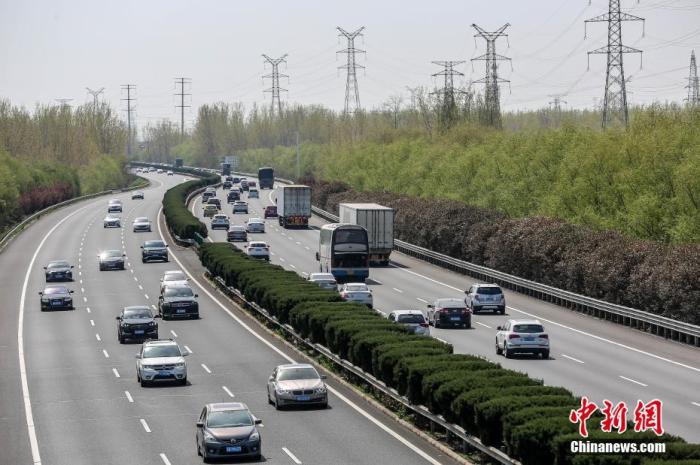Chinanews.com, September 26. How will the road conditions be during the "November" holiday this year?
In this regard, Sun Wenjian, spokesperson for the Ministry of Transport and head of the Policy Research Office, gave travel recommendations and relevant forecast information on the 26th.
Data map: A high-speed section, with a constant stream of passing vehicles (the picture and text are irrelevant).
Image source: Visual China
On the 26th, the State Council Information Office held a press conference on accelerating the construction of new infrastructure in the transportation sector.
At the meeting, a reporter asked, what will happen to the road during the long holiday this year?
Can you share some travel advice and forecast information?
In this regard, Sun Wenjian pointed out that taking into account factors such as epidemic prevention and control during the National Day holiday, weather conditions and free toll roads, it is expected that public travel during the National Day holiday this year will be mainly tourism and family visits. Among them, short-distance and inter-provincial Long-distance travel is equally important, and the proportion of self-driving cars is expected to be relatively high.
Sun Wenjian said that in terms of traffic conditions, it is estimated that the average daily traffic of highways across the country is about 48 million vehicles. Compared with the daily traffic volume in August, the average daily traffic volume since August has been 30.74 million vehicles, which is an increase of about 46% from the daily average in August. In the same period of 2020, it will drop by about 5%, and it will increase by about 5% compared with the same period in 2019.
The average daily cross-sectional traffic of general national and provincial trunk lines is about 8,800 vehicles, an increase of about 4% over the average daily cross-sectional traffic since August.
Sun Wenjian introduced that from a regional perspective, the city peaks on the first day of the holiday are prominent, and the return time is relatively scattered in the later period. It is expected that the Beijing-Tianjin-Hebei, Yangtze River Delta, Guangdong-Hong Kong-Macao, Chengdu-Chongqing and other regions will be more concentrated. Highway sections, urban airport highways, and local sections of highways leading to popular scenic spots are prone to congestion and slow traffic.
Preliminary estimates are that congestion and slow-moving sections of the expressway during the holiday travel period are prone to occur, mainly including the G2 Beijing-Shanghai Expressway Tianjin Section, Jiangsu Wuxi Section and Suzhou Section, G15 Shenhai Expressway, Guangdong Shenzhen Section, G25 Changshen Expressway, Guangdong Huizhou Section, and S20 Shanghai section of Outer Ring Expressway, etc.
During the return period of the holiday, the highway sections prone to congestion and slow-moving mainly include: G2 Beijing-Shanghai Expressway Jiangsu Taizhou Section, G15 Shenhai Expressway Guangdong Shenzhen Section, G40 Shanghai-Shanxi Expressway Shanghai Section, etc.
Among them, the toll stations that are prone to congestion and slow running on the expressway mainly include: G3 Beijing-Taiwan Expressway Tongling Yangtze River Highway Bridge toll station, G10 Suiman Expressway Daqing toll station, G30 Lianhuo Expressway Xi'an Baqiao toll station, etc.
The highway service areas with relatively large traffic mainly include the following: G4 Beijing-Hong Kong-Macao Expressway Shaoguan Qujiang Service Area, G15 Shenhai Expressway Qingdao Jiaozhou Service Area, G25 Changshen Expressway Nanjing Liuhe Service Area, etc.
It is recommended that the majority of car owners and friends should know the weather and road conditions in advance when traveling, choose the travel route and time reasonably, and choose to avoid peak travel as much as possible.
Sun Wenjian said that in order to ensure the travel of the masses during holidays, the Ministry of Transport mainly adopts the following four measures:
The first is to strengthen the guarantee of transportation services, optimize the allocation of transportation capacity, and strengthen the connection between the transportation capacity of road passenger lines, urban public transportation, and taxis with railway trains and civil aviation. The high-speed rail and the "last mile" after getting off the plane are well connected.
The second is to focus on improving the supply capacity of urban and rural passenger transport services.
In view of the superposition of multiple factors in rural areas, such as traveling to visit relatives, returning home and returning to work, busy autumn harvesting and other factors, the travel needs of urban and rural people are guaranteed through encryption frequency, appointment response, and chartered car service.
The third is to focus on optimizing the supply mode of transportation services, and actively carry out road passenger transportation networked ticketing, e-tickets, and customized passenger transportation services.
The fourth is to focus on strengthening epidemic prevention and control and emergency response, adhere to the effective combination of normalized precision prevention and control and local emergency response measures, and strictly implement the disinfection and ventilation of transportation stations and transportation vehicles, transportation organization, temperature testing code, personnel protection, Anti-epidemic propaganda and other measures to strictly prevent the spread of the epidemic through transportation.
Sun Wenjian emphasized that travelers who travel during the holidays should be reminded to wear masks, wash hands frequently, "one-meter line" and other protective measures when entering and exiting public transportation public places. .

